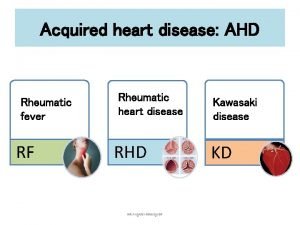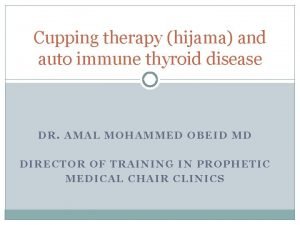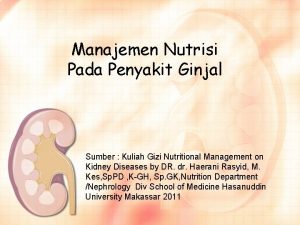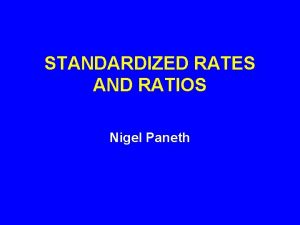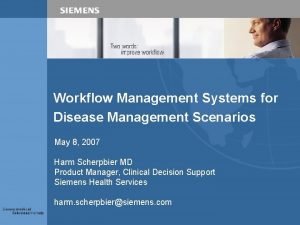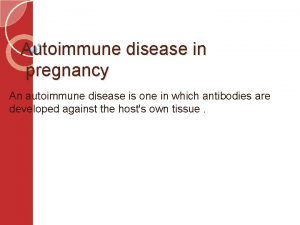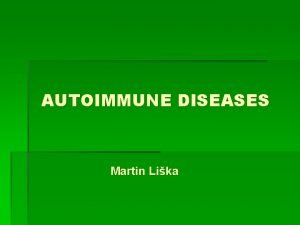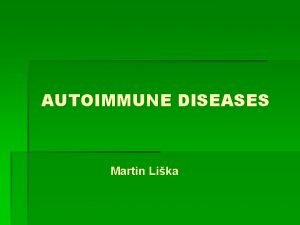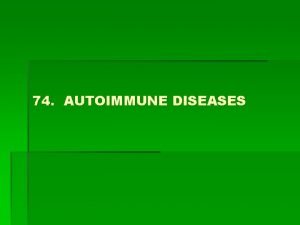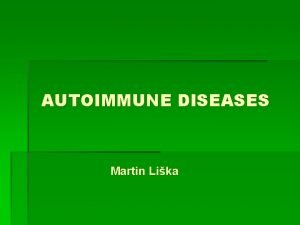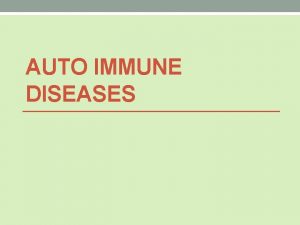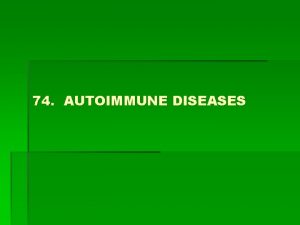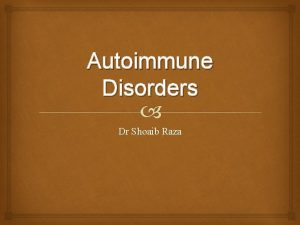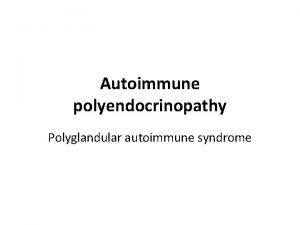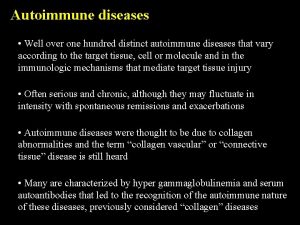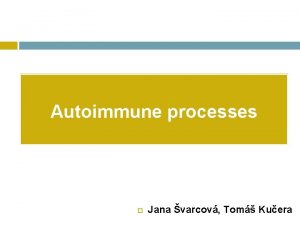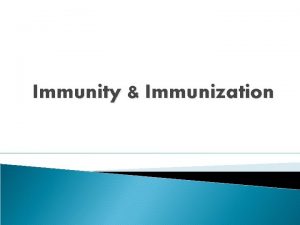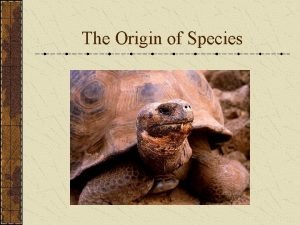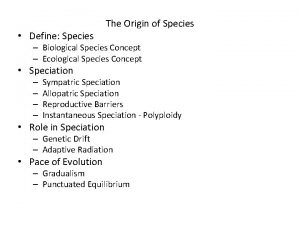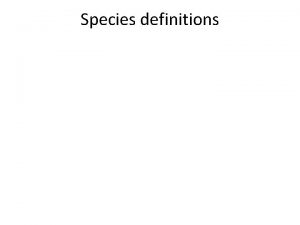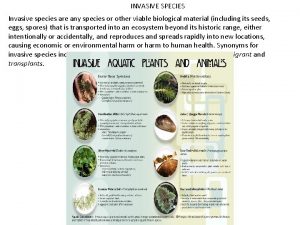FOR A GIVEN SPECIES MHCORGAN SPECIFIC AUTOIMMUNE DISEASE

















































- Slides: 49

FOR A GIVEN SPECIES(? )/MHC/ORGAN SPECIFIC AUTOIMMUNE DISEASE • One Critical Protein • One Critical Peptide • One Critical Register • ? Germline Encoded Critical TCR Segment THUS: Targeting Trimolecular Complex Possible for Prevention HYPOTHESIS THE NOD EXAMPLE

TCR rearrangement Vα Vβ Jα Dβ Jβ

T Cell Receptor Gene Segments Antigen Presenting Cell HLA Molecule Peptide V V D J Chr. 14 J Chr. 6

T cell Recognition of Antigen on an APC Antigen Endocytosis CD 4+ T cell T Cell Receptor APC Peptide MHC II Trimolecular Complex

The Trimolecular Complex NOD MOUSE TCR MHC PEPTIDE INS B: 9 -23

MHC B: 9 -23 TCR Liu et al Diabetes 2012 Zhang et al, J. Diabetes 2011 Michels et al, J. Immunol 2011 MHC B: 9 -23 MHC TCR B: 9 -23 Deletion of T cells expressing specific TCR alpha or TCR beta genes Antibody binds to MHC/peptide complex and blocks it from interacting with TCR Small molecule prevents from binding/dislodges the B: 9 -23 peptide from MHC Interfering with formation of the trimolecular recognition complex


“Stages” in Development of Type 1 A Diabetes (? Precipitating Event) Beta cell mass Genetic Predisposition Overt immunologic abnormalities Normal insulin release Progressive loss insulin release Glucose normal Overt diabetes C-peptide present Age (years) Minimal C-peptide Eisenbarth, 2012


n. POD 6052 -02 Tail: 12 yo 1 year diabetes -Lobular Pseudoatrophic Islets Glucagon/anti-CD 3 Insulin and Ki 67

Type 1 diabetes Anti-insulin: health • No cure; therapy is insulin for life; physiologic glycaemic control never achieved Anti-insulin: disease • Excess morbidity and mortality • Incidence increasing by ~5% every 5 years; costs ~£ 1 billion of UK NHS budget Peakman

Type 1 diabetes is T cell mediated • Infiltrating CD 4+, CD 8+ T cells • Anti-T cell therapies are effective • Islet cell autoantibodies disease CD 4 T-cell CD 8 T-cell CD 4 Treg TCR Epitope HLA II HLA I APC Peakman Islet autoantigen

The Immune System Acquired (Adaptive) Innate • Rapid Microbial Defense • Long-lived Microbial Defense • Adaptive Immune System • Neoplasm surveillance Activation • Autoimmunity, Transplantation Rejection & Atopy BDC

The Innate Immune System • Antimicrobial Peptides (e. g. , Defensins, Cathelicidins) • Phagocytes (Macrophages, Neutrophils, Monocytes, Dendritic Cells) • Pattern Recognition Receptors • Alternative Complement System • NK Cells • B 1 B Cells* * Aspects of both the innate and adaptive immune system BDC

Selected Pattern Recognition Receptors: Toll-like Receptors TLR: Selected Ligands: TLR 1 PGN, Zymosan, Antifungal & Lipoproteins Antibacterial TLR 2 Role in Immunity: TLR 6 TLR 4 LPS Antibacterial TLR 5 Flagellin TLR 11 ? TLR 9 Cp. G Antibacterial & Antiviral TLR 3 ds. RNA Antiviral TLR 7 ss. RNA TLR 8 ss. RNA TLR 10 ? ? Localization: Dendritic Cells, Macrophages, T Cells, B Cells, Epithelium

Selected Pattern Recognition Receptors: Other Families


The Adaptive Immune System • Cell-mediated Immunity (Cytotoxicity) • T cells • CD 4+ (Th 1 & Th 2) • CD 8+ (Tc 1 & Tc 2) • Humoral Immunity (Antibody production) • B Cells BDC

Th 1 and Th 2 CD 4+ T Cells Th 1 Th 2 • IL-12 induces differentiation • • Cytokine Production: • Interferon- Interleukin-2 • Intracellular Pathogens • • Macrophage Activation • • Delayed Type Hypersensitivity • • IL-4 induces differentiation Cytokine Production: Interleukin-4 Interleukin-5 Interleukin-13 Extracellular Pathogens B Cell activation & Ig. E Eosinophil responses Immediate Type Hypersensitivity BDC

T cell signaling molecules and autoimmunity Human T 1 D loci (Ref 1) MHC : λs ≈ 3 Insulin : odds 1. 9 CTLA 4 : odds 1. 2 PTPN 22 odds 1. 7 Cblb : Komeda rat (Yokoi N, Nat Genet, 2002) Pten: Cre-lox. P knock-out (Suzuki A, Immunity, 2001) Zap 70: Sakaguchi mice (Sakaguchi N, Nature, 2003) (Mustelin T, et al. Mol Immunol. 2004) Concannon P et al. Diabetes. 2005 Oct; 54(10): 2995 -3001. H. Ueda

B and T Lymphocyte Antigen Receptors VH VH V CH 1 VL VL CL CL CH 2 Ig /Ig CH 3 V e z z e d C C Ig /Ig fyn lck Zap 70 Blk, Fyn or Lyn 2 light chains ( or ) 2 heavy chains (5 isotypes: Ig. G, M, A, D, E) 2 Binding sites (Divalent) Secreted into circulation Binds Soluble Antigen 2 Chains / (95%) or / (5%) 1 Binding site (Monovalent) Membrane Bound, Not Secreted Binds Antigen Complexed with MHC BDC

J. Noble HLA Human Leukocyte Antigen human MHC cell-surface proteins important in self vs. nonself distinction present peptide antigens to T cells CLASS I: A, B, C CLASS II: DR, DQ, DP

DQB 1*0402 -chain Leu 56 -chain BDC Asp 57 BDC

Hahn, Wucherpfenning et al. Nature Immunology 6: 490 -496, 2005 Topology of Self-peptide/MHC Binding by Ob. 1 A 12 TCR Autoimmune (MBP Peptide+DR 2) Ob. 1 A 12 Anti-viral (HA Peptide+DR 1) HA 1. 7 Red: TCR Yellow: TCR

Hahn, Wucherpfenning et al. Nature Immunology 6: 490 -496, 2005 Ob. 1 A 12 HA 1. 7 Anti-viral (HA Peptide+D R 1) Autoimmune (MBP Peptide+DR 2) Red: TCR Yellow: TCR

The Human Leukocyte Antigen Complex (6 p 21. 31) Class II (1. 1 Mb) DP Class III Class I (2. 2 Mb) (0. 7 Mb) DQ DR B C A Telomere Centromere Frequent Recombination is Rare Complement and Cytokines Class I-like genes and pseudogenes Recombination is Rare BDC

HLA Class I and II Molecules Have a Distinct Structure and Function • Binds 8 -10 mers • Expressed on most Nucleated cells • Presents Cytosolic Proteins to CD 8+ T cells • Binds 13 -25 mers • Expressed on APCs, Macs, B cells, activated T cells • Presents Vesicular Proteins to CD 4+ T cells 1 2 1 1 2 3 2 2 Class II BDC

Cis and Trans- Class II Dimerization Maternal DQA 1 DQB 1 0501 0201 cis DQA 1*0501/DQB 1*0201 Paternal 0301 0302 cis trans DQA 1*0301/DQB 1*0302 DQA 1*0301/DQB 1*0201 DQA 1*0501/DQB 1*0302 BDC

HLA-Peptide: TCR NH 3+ 2 Helix 1 Helix 1 R CD TCR alpha C 2 R D 3 R CD 2 R D 3 C R CD 1 R CD COO- TCR beta BDC

“Tetramer” for T Cell Analysis DQ DQ PEPTIDE DQ Avidin DQ BDC


T cell Recognition of Antigen on an APC Antigen Endocytosis CD 4+ T cell T Cell Receptor APC Peptide MHC II

T cell Activation by an Activated APC IL-1 IL-6 IL-12 Receptor CD 28 “Signal 3” LPS B 7 CD 4+ T cell T Cell Receptor “Signal 2” TLR 4 “Signal 1” Peptide MHC II Antigen Presenting Cell (APC) Signal 1: Specificity Signal 2: Activation Signal 3: Differentiation

The 2 -Signal Model of Lymphocyte Activation Absence of Signal 2 T Cell APC TCR MHC Tolerance Clonal Anergy or Deletion Signal 1 + Signal 2 CD 28 T Cell B 7 APC TCR MHC cytokines Activation BDC

APC and T cell Interactions CTLA-4 B 7 (CD 80/86) CD 28 Activation Recognition TCR MHC II Activation APC CD 58 (LFA-3) Activation CD 40 CD 2 Adhesion CD 40 L CD 4+ T Cell

Molecular Interactions of Helper T Cells and APC CD 4+ T Cell CTLA-4 CD 28 p 56 lck CD 3 CD 40 L C C V CD 2 z zh h d e TCR V CD 45 LFA-1 VLA-1 peptide B 7 CD 80/CD 86 CD 40 MHC II LFA-3 ICAM-1 Collagen APC/ B cell L. Chess

T cell activation is regulated by signals derived from the TCR /CD 3/CD 4 complex and the CD 40 L and CD 28/CTLA-4 co-stimulatory molecules CD 4+ T Cell Antigen specific TCR signals Co-stimulatory signals (- ) / [+] lck d e CD 3 z z hh C C CD 28/ CTLA 4 V CD 40 L [+] , TCR Peptide antigen CD 40 CD 80 (B 7. 1)/ CD 86 (B 7. 2) V CD 4 MHC class II signal Antigen Presenting Cell (APC) L. Chess

TCR CD 4 TCR signaling CD 28 PLC 1 Zap 70 Lck Fyn Tec (PMA) Shc PTK SOS Ras IP 3 + DAG Ca++ Lck Grb 2 PIP 2 (ION) CD 45 PKC MAPK calcineurin NF B NFAT activation Fathman

T cell activation induces expression of functional T cell surface molecules Activated CD 4+ T cell MHC/peptid e Induction and activation of B cells APCs CD 40 L TCR APC TCR Resting CD 4+ T cell Late Activated CD 4+ T cell TCR CD 25 (+) Qa-1/V (-) VLA-1 Collagen TCR (anti-Qa-1/V ) Activated CD 8+ T cell Regulatory CD 8+ T cell Down-regulation of Activated CD 4+ T Cells Migration of sites of inflammation L. Chess

Immunological tolerance • Definition: – specific immune unresponsiveness to an antigen that is induced by exposure of lymphocytes to that antigen (tolerogen vs immunogen) • Significance: – All individuals should be tolerant of their own antigens (self-tolerance); breakdown -->autoimmunity – The induction of tolerance could be exploited to treat autoimmune diseases – Mechanisms of tolerance must first be understood Fathman

Mechanisms of unresponsiveness to self antigens • Central tolerance – Immature self-reactive T lymphocytes that recognize self antigens in the thymus undergo negative selection (deletion) • Peripheral tolerance – Mature self-reactive T lymphocytes that escape central tolerance and recognize self antigens in peripheral tissues can be inactivated (anergy), anergy killed (deletion) or regulated (suppressed) • “Clonal ignorance” – Mature self-reactive lymphocytes do not respond to self antigens in non-inflamed settings Fathman

The Control of Activated CD 4+ T Cells by Regulatory T cells NKT cells/ CD 4+CD 25+ cells CD 4+CD 25 - cells Apoptosis peptide/APC (- ) TH 1 CD 4+ cells IL-12/ IFN- (- ) IL-10 IL-4 Resting CD 4 T cells IFN- (- ) Activated CD 4 T cells (- ) TH 2 CD 4+ cells Regulatory immunity CD 4/CD 8 interactions CD 8 or CD 4 suppressor effector precursor L. Chess

Regulatory T Cell Subsets

Regulatory T Cells in Autoimmunity BDC Roncarolo et al. Curr Opinion Immunol 2000

XPID: X-linked Polyendocrinopathy, Immune dysfunction and Diarrhea Foxp 3 Gene Essential CD 4 -CD 25 T Reg • XLAAD: Autoimmunity Allergic Dysregulation • Defect in scurfin protein (gene = Foxp 3/JM 2) or “scurfy mouse” • Immunopathogenesis relates to a deficiency of T regulatory cells -Scurfy x Nude: No Autoimmunity -CD 4+ T cells into Nude: Disease -Bone Marrow into irradiated: No Disease -Mixed Chimera: No Disease BDC

Requirements for the development of an autoimmune disease Nature Immunology (9): 759 -761 (2001) Fathman

Immunopathophysiology of Diabetes Dendritic cell/ APC CD 2 CD 4+ Cell (TH 0 ) IL-12 DR 3, DR 4, , DQ 8/insulin , , TCR peptide IFN- IL-4 CD 4+ Cell (TH 2 ) CD 40 L CD 40 Macrophage/dendritic cell Fc R Fas. L perforin CD 40 L Activated TH 1 CD 4+ T Cell CD 8+ CTL IL-1, TNF, LT, NO, PGE-2 IL-4 CD 40 L B Cell ? anti-insulin, GAD ab anti. Mog ? Antibody mediated injury cell death islet cells L. Chess

Induction of CD 4+ TH 1 mediated autoimmunity: A paradigm for the pathogenesis of rheumatoid arthritis, multiple sclerosis and type I diabetes (1) expansion of CD 4+, autoreactive TH 1 cells specific for autoantigens MHC/self-peptide CD 4 TCR V x CD 4+ V x T cell APC CD 4 MHC/V TCR V x Activated autoreactive CD 4+ TCR V x TH 1 cell (2) migration and infiltration of these self reactive CD 4+ TH 1 cells into tissues and induction of inflammation and autoimmunity (3) induction of regulatory cells which control the growth and activation of the pathogenic autoreactive repertoire of CD 4+ T cells L. Chess

1984: Subset Participants Immunology in Diabetes Rome
 Ahd heart
Ahd heart Thyroid hijama points
Thyroid hijama points Penyebab pew pada ckd
Penyebab pew pada ckd Crohn's disease test
Crohn's disease test Define keystone species in biology
Define keystone species in biology Homo habilis handy man
Homo habilis handy man Communicable disease and non communicable disease
Communicable disease and non communicable disease Disease specific mortality rate formula
Disease specific mortality rate formula Disease-specific workflows
Disease-specific workflows Specific gravity to specific volume
Specific gravity to specific volume Plummet method
Plummet method Rutin för avvikelsehantering
Rutin för avvikelsehantering Tes debattartikel
Tes debattartikel Treserva lathund
Treserva lathund En lathund för arbete med kontinuitetshantering
En lathund för arbete med kontinuitetshantering Myndigheten för delaktighet
Myndigheten för delaktighet Tack för att ni lyssnade
Tack för att ni lyssnade Tobinskatten för och nackdelar
Tobinskatten för och nackdelar Mall för referat
Mall för referat Formel för lufttryck
Formel för lufttryck Tack för att ni har lyssnat
Tack för att ni har lyssnat Programskede byggprocessen
Programskede byggprocessen Vad är densitet
Vad är densitet Mitos steg
Mitos steg Presentera för publik crossboss
Presentera för publik crossboss Rbk fuktmätning
Rbk fuktmätning Elektronik för barn
Elektronik för barn Kung som dog 1611
Kung som dog 1611 Tack för att ni har lyssnat
Tack för att ni har lyssnat Typiska novell drag
Typiska novell drag Smärtskolan kunskap för livet
Smärtskolan kunskap för livet Delegerande ledarskap
Delegerande ledarskap Adressändring ideell förening
Adressändring ideell förening Trög för kemist
Trög för kemist Punkthöjd karttecken
Punkthöjd karttecken Epiteltyper
Epiteltyper Multiplikation med uppställning
Multiplikation med uppställning Toppslätskivling dos
Toppslätskivling dos Svenskt ramverk för digital samverkan
Svenskt ramverk för digital samverkan Borra hål för knoppar
Borra hål för knoppar Bris för vuxna
Bris för vuxna Mat för idrottare
Mat för idrottare Datorkunskap för nybörjare
Datorkunskap för nybörjare Argument för teckenspråk som minoritetsspråk
Argument för teckenspråk som minoritetsspråk Ledarskapsteorier
Ledarskapsteorier Kvinnlig mantel i antikens rom
Kvinnlig mantel i antikens rom Ellika andolf
Ellika andolf Rita perspektiv
Rita perspektiv Tack för att ni lyssnade bild
Tack för att ni lyssnade bild Nyckelkompetenser för livslångt lärande
Nyckelkompetenser för livslångt lärande
